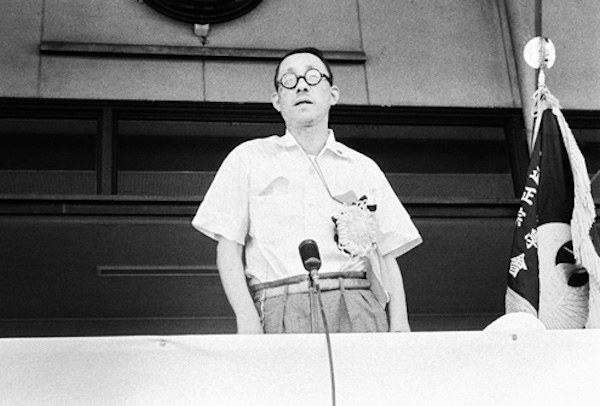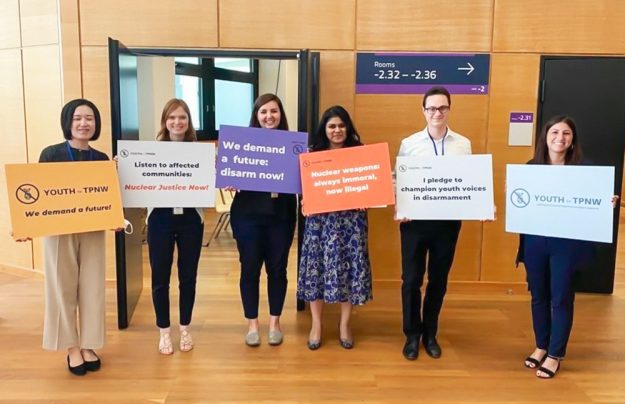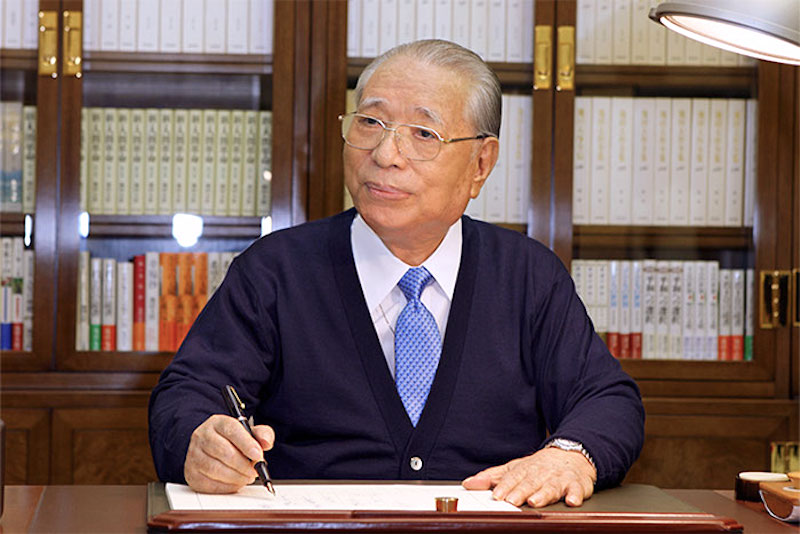Last month, amid the ongoing Russian invasion of Ukraine, Daisaku Ikeda, president of Soka Gakkai International, the nongovernmental organization that serves as an umbrella group for the world’s largest sect of Nichiren Buddhism, pleaded for the five nuclear weapon states—including Russia—to commit to never being the first to use nuclear weapons in a conflict.
“In a world where divisions are as deep as they have ever been, it is crucial that all the nuclear-weapon states clearly declare that they intend to maintain the stance of self-restraint with regard to nuclear war,” he said, ahead of the review conference for the states party to the Treaty on the Non-Proliferation of Nuclear Weapons, which concluded on August 26.
While for many the issue of nuclear abolition has faded to the background after the Cold War, members of the Soka Gakkai movement have been fighting for nuclear abolition for more than 60 years—and say that the war between Russia and Ukraine should be a stark reminder of the imminent and existential threat nuclear weapons pose to humanity.
“As Buddhists, we believe in the utmost dignity of life, that life is so precious,” said Anna Ikeda, a representative for SGI at the UN. “Nuclear weapons destroy life on such a broad scale in an instant, so of course we should be enraged at them.”
This commitment to nuclear abolition is actually intertwined with the foundation of SGI itself, Joan Anderson, of the group’s international office of public information, points out.
Soka Gakkai traces its roots to 1930s Japan, during the lead up to World War II. Its two founders, Tsunesaburo Makiguchi and Josei Toda, were schoolteachers who opposed Japan’s growing militarism and imposition of the Shinto religion, and were later imprisoned for publicly resisting it, Anderson said. Makiguchi died in prison.
“Resistance to nationalism and to the war is in-built in SGI members,” Anderson said.
Toda was released from prison in July 1945, one month before the United States dropped atomic bombs over Hiroshima and Nagasaki, which killed more than 200,000 people, most of them civilians, and leaving thousands of survivors, known in Japanese as hibakusha, with cancer and other health effects from the radiation. Toda then began rebuilding Soka Gakkai in the war’s aftermath.

In 1957, at the height of the Cold War and months before his death, Toda delivered a declaration on the abolition of nuclear weapons, which became the foundation for Soka Gakkai’s work on nuclear abolition.
“We, the citizens of the world, have an inviolable right to live,” he said. “Anyone who jeopardizes that right is a devil incarnate, a fiend, a monster. I wish to declare that anyone who ventures to use nuclear weapons, irrespective of their nationality or whether their country is victorious or defeated, should be sentenced to death without exception.”
His strong language was a response to the global arms race and ballooning of nuclear stockpiles at the time, Anderson said.
“I think he felt that it’s not the case that there are good nuclear weapons and bad nuclear weapons, that having nuclear weapons in the hands of the United States is fine, but in the hands of the Soviet Union is bad,” she said. “What he said was, we have to stop this kind of thinking, nuclear weapons are a threat to all life, and there’s no such thing as a limited nuclear war.”
After Toda’s declaration, Soka Gakkai started an extensive international campaign for nuclear abolition. One of the organization’s first activities was interviewing hibakusha to document their experiences with nuclear war and suffering. By tasking young members with collecting these testimonies, he was able to educate a new generation about nuclear weapons, Anderson said.
Soka Gakkai also put together exhibitions about the human toll of nuclear weapons, which have been showcased around the world, and launched other public education campaigns. In 1983, Soka Gakkai International registered as a nongovernmental organization with the United Nations, where it’s also been pushing for abolition on a global scale.
SGI is a partner organization of the Geneva-based International Campaign to Abolish Nuclear Weapons (ICAN), which was awarded the 2017 Nobel Peace Prize. SGI also works on the Treaty on the Non-Proliferation of Nuclear Weapons (NPT)—an agreement among the world’s five nuclear powers to prevent the spread of nuclear weapons—and the Treaty on the Prohibition of Nuclear Weapons—an agreement led by non-nuclear countries that aims to ban all development or production of nuclear weapons.

And in the United States, SGI-USA is currently working with the Back from the Brink campaign—a coalition of faith and civic groups, including the Union of Concerned Scientists, the Sierra Club, and several mainline Protestant denominations—to push a domestic policy platform that includes renouncing the first use of nuclear weapons; ending the president’s sole, unchecked authority to launch nuclear war; taking nuclear weapons off hair trigger alert status; and abandoning the plan to update the US’s arsenal with enhanced weapons.
Anna Ikeda said that as a Buddhist civil society organization, SGI’s role in the fight for nuclear abolition is to strengthen international norms and remind people of the human toll that’s at stake, since governmental discussions about nuclear weapons are typically “sanitized” and focus on numbers and military strategy.
“It’s to the point where you don’t really hear about human suffering,” she said. “So it’s the role of SGI, ICAN, and others to put human suffering at the center of the debate.”
Another noteworthy attribute of SGI’s nuclear abolition work is that youth have always played a significant role, Danny Hall, public affairs director for SGI-USA, pointed out. (Daisaku Ikeda wrote in 2009, “It is the passion of youth that spreads the flames of courage throughout society.”) Student groups have for decades hosted exhibitions on their college campuses and disseminated petitions to raise awareness.
Even though nuclear abolition isn’t often at the forefront of the minds of young people, who weren’t alive during the Cold War, Hall said it should be. By some measures, the risk of nuclear war is even greater now than it was during the Cold War, he said, since the number of nuclear weapons has once again started to grow. In addition, he said, “nuclear weapons don’t exist in a vacuum; they intersect with issues young people care about.”
Nuclear weapons can exacerbate the climate crisis, and nuclear testing and waste have disproportionately impacted marginalized people and communities of color, he said. It’s also an issue of economic justice: The US will spend nearly $2 trillion over 30 years to update its nuclear arsenal, money that could be used for housing, healthcare, or schools, he said.
Finally, for SGI, nuclear abolition isn’t just about politics; it’s also about spirituality.
Anna Ikeda said that in SGI’s view of Buddhism, nuclear weapons are “a manifestation of what we call the fundamental darkness. It’s our inability to see our own dignity and the dignity of others.” Because of this, she said it’s critical not just to abolish nuclear weapons themselves, but also the types of thinking that have led people to develop—and use—them in the first place. “We could destroy all nuclear weapons from earth, but if you don’t change human tendencies, it’s going to be something else,” she said.
Her views reflect that of Daisaku Ikeda, who in 2009 wrote, “If we are to put the era of nuclear terror behind us, we must struggle against the real ‘enemy.’ That enemy is not nuclear weapons per se, nor is it the states that possess or develop them. The real enemy that we must confront is the ways of thinking that justify nuclear weapons; the readiness to annihilate others when they are seen as a threat or as a hindrance to the realization of our objectives. This is the new consciousness we must all share.”
SGI members understand that they face an uphill battle to achieve a world free of nuclear weapons.
“Is it possible? I don’t know,” Hall said.
“But it’s a matter of faith to continue to make this effort for a world free of nuclear weapons,” he said. “Our goal is not to be resigned to nuclear war as an inevitability, but to believe that a better world is possible and that we can make a difference.”
Thank you for subscribing to Tricycle! As a nonprofit, we depend on readers like you to keep Buddhist teachings and practices widely available.
